Japan and South Korea seem willing to bury the hatchet over wartime abuses of Korean women. There are still several points of disagreement, but both countries want to push the issue aside in order to cooperate on more pressing security challenges.
Japan and the Republic of Korea (ROK) share an acute awareness of an unstable regional security environment, marked by a threatening North Korean regime and a progressively more assertive China. Aiming to strengthen security cooperation in particular, both countries therefore seek to address differences over wartime history.
On 28 December 2015 Tokyo and Seoul reached an agreement on the lingering issue of institutionalized military-related prostitution before and during the Second World War. Although exact numbers are unknown, tens of thousands of Korean women, but also women from China, Taiwan, and other countries, were forced to work in Japanese military brothels.
The end-of-the-year deal supposedly settled the so-called “comfort women” issue once and for all, in a “final and irreversible” way. According to the agreement, Japan would provide funding, directly from the national budget, to the tune of 1 billion yen (approximately 7.8 million euros) for a new foundation to provide humanitarian support for the victims. Prime Minister Shinzō Abe would apologize and express remorse to the 46 remaining former comfort women.
Multiple factors drove the agreement forward. Most importantly, the issue has obstructed security co-operation between the two countries. In 2012, for example, South Korea cancelled the signing of an agreement to share military intelligence. The external threat of the ongoing North Korean nuclear programme and missile technology development was an important catalyst for both countries to seek rapprochement.
Second, historical issues including but not limited to that of the comfort women impinged on trade relations, as Japanese exports to and imports from South Korea have been declining for the past few years. Other thorny issues include the depiction of wartime history in Japanese school textbooks, the territorial dispute between both countries over the Dokdo/Takeshima islets controlled by South Korea, and the role of controversial sites strongly associated with Japan’s militaristic past such as the Yasukuni Shrine.
Third, the timing of the agreement was highly symbolic, as 2015 marked the 70th anniversary of the end of World War II, and the 50th anniversary of the normalization of relations between Japan and the ROK.
Fourth, domestic politics played a role. It was one of PM Abe’s personal goals to improve relations, particularly with the upcoming Upper House elections of next summer in mind. Exactly three years in office, Abe was crucially aware that poor relations with close neighbours can adversely affect electoral outcomes. South Korean President Park Geun-hye also faces elections in April this year.
Fifth, the US certainly exerted pressure on both governments to reach a deal, as troubled relations between two of the US’s key allies in the region would have a negative impact on US ambitions to remain the most important security provider in East Asia. Finally, the agreement should also be seen in the context of Tokyo’s efforts to forge strategic relations with other countries in order to counter China’s growing regional clout.
The road towards an ultimate resolution of the issue remains rocky, not least because of domestic resistance. Public opposition in the ROK remains strong: according to a public opinion poll conducted immediately after the agreement, only 19.3% of the South Korean public support the deal, whereas 66.3% are against.
In Japan, conservative forces oppose the use of public funds to assist the comfort women. The most delicate problem is a statue symbolizing comfort women, erected in 2011 by the Korean Council for Women Drafted for Sexual Slavery by Japan, right in front of the Japanese embassy in Seoul, where Korean activist groups have been holding weekly demonstrations. The Japanese have asked for its removal, separate from the formal agreement, whereas the South Korean government promised to “strive to solve this issue in an appropriate manner through taking measures such as consulting with related organizations about possible ways of addressing this issue”.
Furthermore, disagreements continue on how the comfort women system is addressed in Japanese history textbooks, particularly as to the number of women exploited and the degree to which the military were directly involved in their forced recruitment.
Finally, lingering disagreement over legal responsibility, a key reason why the issue has remained an impediment for such a long time, can prevent the dispute from being settled permanently. The Japanese side maintains that the issue was resolved in 1965, when relations between both countries were normalized, even if Tokyo now accepts moral responsibility. Korean civic groups continue to insist that the Japanese government needs to formally acknowledge legal responsibility as part of the agreement, impacting the stance of Korean political leaders.
In short, numerous concerns remain that could critically lessen the impact of the December agreement, or even nullify it. Yet both governments have pledged that the agreement settles the issue finally and irreversibly, and both sides have agreed they will stop criticizing each other over the issue in international institutions such as the UN.
Fully aware of the need to co-operate in defence, security, as well as the economy, both Park and Abe reached a highly significant compromise. Caution remains warranted, but if both sides remain true to their commitment and can resist domestic pressures, the deal marks an important step forward in rebuilding relations of trust between the two countries.








